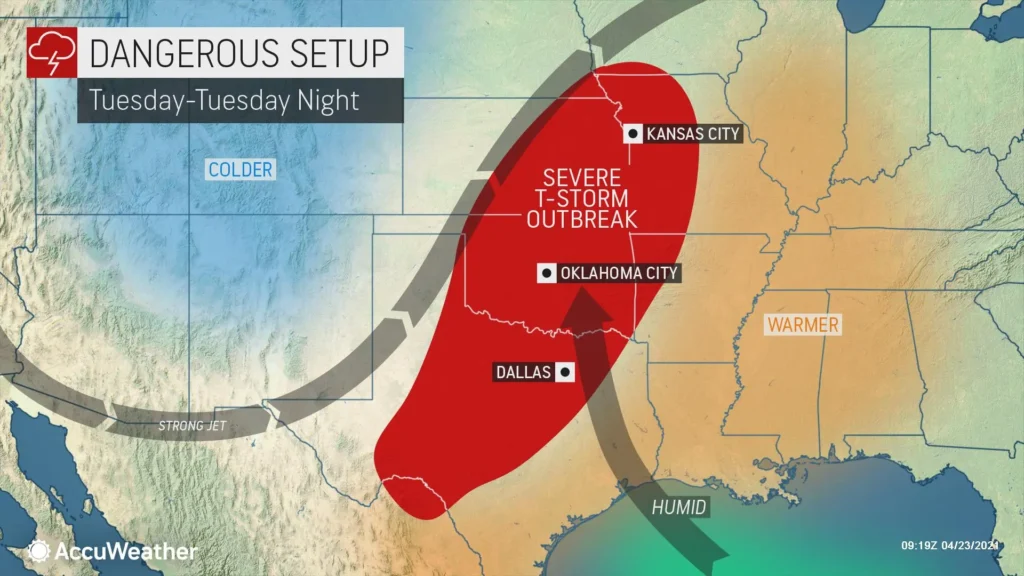Severe Thunderstorm Outbreak: Nature’s Tempest on Full Display
6 min read
Severe Thunderstorm Outbreak: Nature’s Tempest on Full Display
Ah, the weather! One minute it’s sunny and calm, and the next minute—bam! Mother Nature decides to spice things up with a severe thunderstorm outbreak. If you’ve ever been caught in one, you know exactly how it goes: wind howling, lightning flashing, and rain coming down so hard you’d think the sky sprung a major leak. But what exactly is a severe thunderstorm outbreak, and why do these storms make us want to hide under the nearest table with a flashlight and a blanket?
Let’s dive into the science, the danger, and yes, a few fun moments that these storms can bring (if you can call a tree falling through your backyard fence “fun”).
What Is a Severe Thunderstorm Outbreak?
First things first—let’s get to the heart of what we’re dealing with here. A severe thunderstorm outbreak is when a series of powerful thunderstorms form over a large area, typically causing widespread damage. These aren’t your typical rain showers. We’re talking about heavy rain, intense lightning, strong winds (we’re talking speeds over 58 mph), large hail, and sometimes—just for that extra drama—tornadoes.
Think of it like nature’s way of throwing a giant tantrum. Maybe the Earth is in a bad mood, or perhaps the atmosphere had one too many cups of coffee. Either way, it’s not a time to plan a picnic.
Why Do Severe Thunderstorm Outbreaks Happen?
It’s not like the weather just wakes up one morning and says, “You know what would be fun today? Let’s throw a severe thunderstorm outbreak!” There are actual scientific reasons behind these dramatic weather events. It all starts with unstable air masses. You need three key ingredients:
- Moisture: Thunderstorms love moisture. Think of it as the fuel they need to get going. The more moisture in the atmosphere, the stronger the storms.
- Lift: You also need something to lift that moist air upward. This could be a cold front, warm front, or even the terrain (like mountains).
- Instability: This is the key. Instability occurs when the air near the ground is much warmer and more humid than the air above it. When this warm air rises into the cooler atmosphere, it can create towering clouds. The result? Thunderstorms. Lots of them.
When these conditions come together on a large scale, we get what’s known as a severe thunderstorm outbreak. And when that happens, it’s time to buckle up.
The Wild Side of Severe Thunderstorms
Severe thunderstorms don’t just mess with our evening plans. They come with a whole list of dramatic effects. Let’s break it down:
- Lightning: Nature’s ultimate light show. While it may look cool from a distance, lightning is dangerous. It’s like Mother Nature showing off with her version of an electrical power surge. If you’ve ever jumped out of your seat from a lightning strike that’s way too close for comfort, you know it’s no joke.
- Strong Winds: When we say strong winds, we’re not talking about a gentle breeze blowing your hair in the wind. No, these winds can knock down trees, power lines, and even flip over your patio furniture like it’s nothing. If you’ve ever seen your trash can racing down the street in 60 mph winds, you know what we’re talking about.
- Hail: Now, let’s add some frozen chaos to the mix. Hailstones can range from the size of peas to as big as softballs. Yes, you read that right—softballs. Imagine a round of mini meteors crashing down on your car. Time to hope your insurance policy covers “bizarre acts of weather.”
- Tornadoes: If all the above isn’t enough to grab your attention, severe thunderstorms can also spawn tornadoes. These spinning funnels of doom add another level of terror to an already intense situation. The roar of a tornado is often compared to a freight train, but you can’t exactly catch a ride on this one. Better to stay indoors and, you know, not chase it like in the movies.
Fun(?) Facts About Thunderstorms
Alright, let’s lighten things up a bit—because even a severe thunderstorm outbreak has its quirks. Here are a few fun facts about these tempests:
- Lightning is hotter than the surface of the sun: Yep, lightning can heat the air around it to 30,000 degrees Celsius. So, next time someone says “you’re on fire,” at least you’re not as hot as a lightning bolt (though you might feel like it after a close call).
- Thunder can’t hurt you, but it sure can scare you: Thunder is just the sound of lightning’s shockwave. It can’t hurt you, but it sure can make you spill your coffee all over your new shirt. And that’s a different kind of disaster.
- Hailstones have layers, like onions: Just like Shrek! Hail forms in layers, getting bigger each time it’s lifted into the storm. You might not want to take a bite out of one, though.
Safety Tips for Surviving a Severe Thunderstorm Outbreak
Now, all jokes aside, a severe thunderstorm outbreak is serious business. So, how can you stay safe when these storms decide to make an appearance?
- Find Shelter: First and foremost, get inside! The safest place is in a sturdy building. Don’t be that person who tries to outrun a thunderstorm or take shelter under a tree (hint: trees and lightning don’t mix well).
- Avoid Electrical Appliances: Unplug electronics. We’re talking about that TV, your toaster, and yes, even your beloved phone. Lightning likes to travel through power lines, and you don’t want to be the one testing that theory.
- Stay Away from Windows: Those big gusts of wind could send debris flying through your windows. As much as you might want to watch the storm unfold, it’s better to stay clear of glass.
- Don’t Take a Shower: Okay, this one might seem odd, but water conducts electricity. If lightning strikes your house, it can travel through your plumbing. So, postpone that bath until the storm passes. Your rubber ducky will understand.
- Tune In for Warnings: Listen to the weather forecast. If they say a severe thunderstorm outbreak is on the way, take it seriously. And hey, if you get to watch your local weather anchor try to pronounce all the tricky meteorological terms—bonus entertainment!
How to Find Humor in a Severe Thunderstorm Outbreak (Yes, Really!)
Look, we get it. It’s hard to laugh when your power’s out, your backyard looks like a swamp, and you’re using candles because your phone’s at 5% battery life. But, as with most things in life, a little humor can help lighten the mood—just like that candle you’re holding.
For example, have you ever noticed that thunder always waits until you’ve just dozed off to make its grand entrance? It’s like the weather is auditioning for a role in a horror movie. Or how about the fact that your neighbor’s garden gnome is now sitting in your driveway, looking like it’s ready to hitchhike to safety? Classic storm chaos.
In Conclusion: When Nature Throws a Fit, You Stay Smart
A severe thunderstorm outbreak is no laughing matter—well, except when your lawn furniture ends up two houses down, but we digress. These storms are powerful, unpredictable, and capable of causing serious damage. But with a little preparation, a lot of caution, and maybe even a dash of humor, you can ride out the storm safely.
So next time you hear that rumble in the distance and the weather app warns of a severe thunderstorm outbreak, grab your flashlight, put away your outdoor cushions, and hunker down. And remember, even if you’re caught in the middle of nature’s tantrum, there’s always a story to tell afterward—preferably one with plenty of sound effects and dramatic pauses!



